YOUR ARM WORKOUTS are, more than likely, focused on two very important muscles: the biceps and triceps. These big muscles take up the front and rear of your upper arms, respectively. They’re notable both in terms of function—your biceps are tasked with elbow flexion, your triceps with extension—and aesthetics, since big, well-apportioned arms are a hallmark of fitness prowess. The area below your upper arms isn’t just no man’s land. Your forearms are important to train, too. But far too often, those muscles are neglected.
That’s foolish from multiple standpoints. Right off the bat, you’ll look unbalanced with a pair of big guns at the top of your arms and little twigs at the bottom. Forearms are one of those sneaky body parts potential partners find the most attractive, so you’re potentially doing your romantic life a disservice if you’re not giving even a bit of attention to the muscle group. Your forearm muscles serve an important function, too. They’re essential for your grip–which is a more valuable characteristic than you might expect.
So, how do you go about training your forearm muscles? There are some schools of thought that hold that you don’t actually need any dedicated forearm work in your strength training split. Yes, you’ll get quite a bit of forearm stimulus through heavy barbell movements like deadlifts and rows or even pullups—but there’s still room for more, in our opinion.
In fact, a program with lots of grip-intensive exercises can be better supported with direct forearm training, since the grip might wind up being the point of failure. By including some focused forearm training into your workout program, you’ll be even better equipped for those aforementioned exercises (lack of forearm strength is why people feel the need to turn to tools like wrist straps and grips when pulling heavy weights, after all).
Benefits of Training Your Forearm Muscles
As we’ve established, there are the obvious aesthetic benefits of forearm training. You’ll balance out your lower arms to your upper arms and fill out your long-sleeve shirts better. When it comes time to train, your grip will also benefit, making heavy barbell exercises like deadlifts and rows stronger—and having real world benefits when it comes time to handle chores like carrying grocery bags.
But there are even more pressing reasons to include some dedicated forearm exercises into your workouts: your lifespan. Grip strength is often used as a predictor of overall health and longevity, and some researchers consider it to be more effective for the task than other commonly-used measurements like muscle mass. If you follow that logic, the stronger your grip is, the more likely you are to be able to live a healthy life. Giving your forearms more training attention becomes an even better idea with that mindset.
How and When to Train Your Forearms
In theory, you train your grip during every workout, of course. One of the best ways to train your forearms is to grip everything with intent, squeezing tightly on the bar, whether you’re doing pullups or rows or deadlifts. The more you grip the stronger and more consistent that grip will get.
But every so often, it doesn’t hurt to add some intentional forearm work into your training, too, because that can bring up weak points, and it’ll ready you to grip with more intent on all those other movements. So add these moves into your workouts.
You don’t need to work through marathon forearm training workouts, of course. Instead, inject light forearm training into every session. It’s easy to do 1 or 2 forearm exercises at the end of a standard workout. Just do 2 to 3 sets of each move.
Forearms are much like calves and abs, too: They’re a muscle group that should get routine work almost every day. That means you don’t need to take a “rest” day from training forearms. Don’t be afraid to inject them into five to six days a week of training; your grip strength will benefit and it can be trained with that kind of frequency.
One easy way to think about this then: Choose one forearm exercise from the list below, and do 3 sets of it once a day at the end of your workout. It’s a guaranteed arm pump at the end of every single day. (And there’s never anything wrong with that.)
Your Forearm Building Exercises
Reverse Curl
This classic exercise inverts one of the most common moves in the gym (the biceps curl) to shift its focus to the brachioradialis, the muscle on the front of your forearm.
How to Do It:
- Stand with your feet about shoulder-width apart, holding the bar with a pronated (palms down) grip. Squeeze your glutes, core and shoulder blades to create full-body tension.
- Lift the weight up, moving only at the elbows.
- Pause at the top, then lower back down to the starting position.
Farmer’s Carry
The classic Farmer’s Carry will pump up your forearms more than you might expect: you’re gripping heavy bells as you walk.
How to Do It:
- Stand holding weights in both hands. No matter what implement, squeeze the handles tightly.
- Squeeze your shoulder blades and keep your core engaged.
- Walk forward, keeping your gaze in front of you with your neck in a neutral position and keeping your core tight.
Kettlebell Swing
Yes, you need to grip the bells tightly when you swing, and that will lead to plenty of organic forearm work.
How to Do It:
- Start with the kettlebell on the floor in front of you on the floor, standing with your feet just outside shoulder-width apart. Hinge at the hips, reaching to grasp that handle. Grip tightly.
- Pull the weight back to ‘hike’ it between your legs, then stand straight up into extension to drive the weight up. Your arms shouldn’t drive the movement; think of them as ropes attached to the bell.
- Allow the bell to travel up as high as your thrust takes it; don’t worry about reaching an arbitrary height.
- Allowing the bell to swing back between your legs (while maintaining the integrity of your hip hinge), then carry into the next rep.
Deadlift
The classic deadlift, without wraps, is a potent weapon in building massive forearms. The key: Don’t use wraps and don’t use a mixed grip. If you force your hands to handle the grip work, it won’t be easy to lift, and you may have to go a bit lighter than you would with straps, but your forearms will get a heavyweight challenge lifting a large load.
How to Do It:
- Stand in front of the barbell, close to or touching with your shins.
- Push your butt back and hinge at the hips to grasp the bar in both hands in an overhand grip. This is essential for the forearm engagement.
- Get into position with your hips below your shoulders. Set your lats, squeeze your shoulder blades together, and pull the slack out of the bar. Engage your core.
- Push off the floor with both feet and stand up to pull the weight, keeping it as close to yourself as possible. Squeeze your glutes at the top of the movement.
Bottoms-Up Clean to Rotation
The bottoms-up clean will tax your forearms to balance a load at the top of each clean. Adding the rotation makes that balance even more challenging.
How to Do It:
- Get into a tall-kneeling position, holding a pair of kettlebells by the handles.
- Clean the kettlebells up simultaneously into the bottoms-up position. To do this, your forearms should be perpendicular to the ground.
- Pause for a beat. Rotate your wrists in toward each other, then back, keeping the weights in position.
- Allow the weights to fall back to the starting position. Here, you can use momentum to swing into the next rep.
Towel Hammer Curl
Grabbing a dumbbell or kettlebell via towel is a perfect way to build forearm strength, adding a grip challenge to every curl rep.
How to Do It:
- Wrap a towel around the handle of a kettlebell. Grip each side of the towel tightly, with your palms in a neutral position, holding the weight up.
- Curl the weight up, moving only at the elbows.
- Lower the weight back down, continuing to grip the towel tightly.
Hanging Leg Raise
Yes, the main focus here is on your core—but hanging exercises like the leg raise are only possible with a rock solid grip. Emphasize your forearms by making sure your palms are all the way over the bar, then squeeze tightly.
How to Do It:
- Raise your arms above your head to grasp the bar. Grip tightly, with your palms on top of the bar.
- Lift your legs up to hang, squeezing your shoulder blades. Create tension in your core. Pull your ribcage tight, with your legs slightly in front of your torso.
- Bend your knees slightly, then curl your legs up, using your abs to drive the movement.
- Lower back down, keeping your legs in front of your torso.
Towel Inverted Row Hold
Blast back, biceps, and forearms all at once with this challenging isometric hold. The greatest challenge may come to your forearms here: They have to grip tightly or you list slipping down the towel.
How to Do It:
- Start underneath the bar, with your legs extended straight out and feet elevated on top of a bench or platform. Loop the towel around the bar and grip tightly with both hands.
- Pull yourself up and hold in a straight body position parallel with the ground. Squeeze your core and glutes to create tension.
- Hold the position for 30 seconds
Ultimate Peak Biceps Curl
Yes, you’re blasting biceps and brachialis on this curl, too. But adding in the twist midway through and controlling the descent will also blast your forearms, especially as you go heavier in weight.
How to Do It:
- Perform one full dumbbell biceps curl. Lower until your forearms are parallel to the ground, then pause.
- Curl all the way back up from that position, using only your biceps.
- Repeat the cycle for eight to 10 reps.
Total Arm Countdown Finisher
This well-rounded finisher blasts biceps and triceps, and includes a generous helping of hammer curl work, too, which is perfect for building your forearms.
How to Do It:
- Lie on a bench with a pair of dumbbells. Perform three double skull-crusher to JM press reps.
- Sit up and perform three sets of double biceps curls to hammer curls.
- Work down the ladder, repeating each movement. Continue squeezing the dumbbells, hard.
Turkish Getup Challenge
Racking up time with a kettlebell upside down is destined to build forearm strength, because the balance component is tricky. Here, you’ll do that, and have to balance the bell through a ton of total-body movement, which will lead to a generous forearm pump after each completed rep.
How to Do It:
- Lie on the ground, holding a kettlebell in the bottoms-up position raised above your torso.
- Perform the first section of a Turkish getup, lifting your shoulders and upper torso off the floor. Lower back down.
- Progress to the second, third, fourth, then fifth steps of the movement. Focus to keep the kettlebell balanced in the bottoms-up position.
Spider Curl Finisher
A unique bend of alternating biceps and hammer curl work, this series places your forearms under plenty of tension. Grip the dumbbells tightly throughout for even more forearm work.
How to Do It:
- Sit on an incline bench set at a 30 degree angle with your chest on the pad, holding a single dumbbell. Flex your abs and upper back muscles.
- Perform one hammer curl rep.
- Immediately perform one biceps curl rep. Don’t lower all the way down; pause when your forearms is parallel to the floor (elbow at 90 degrees).
- Continue repeating this cycle for one minute, gripping the dumbbell handle tightly.
Ebenezer Samuel, C.S.C.S., is the fitness director of Men’s Health and a certified trainer with more than 10 years of training experience. He’s logged training time with NFL athletes and track athletes and his current training regimen includes weight training, HIIT conditioning, and yoga. Before joining Men’s Health in 2017, he served as a sports columnist and tech columnist for the New York Daily News.
Brett Williams, a fitness editor at Men’s Health, is a NASM-CPT certified trainer and former pro football player and tech reporter who splits his workout time between strength and conditioning training, martial arts, and running. You can find his work elsewhere at Mashable, Thrillist, and other outlets.


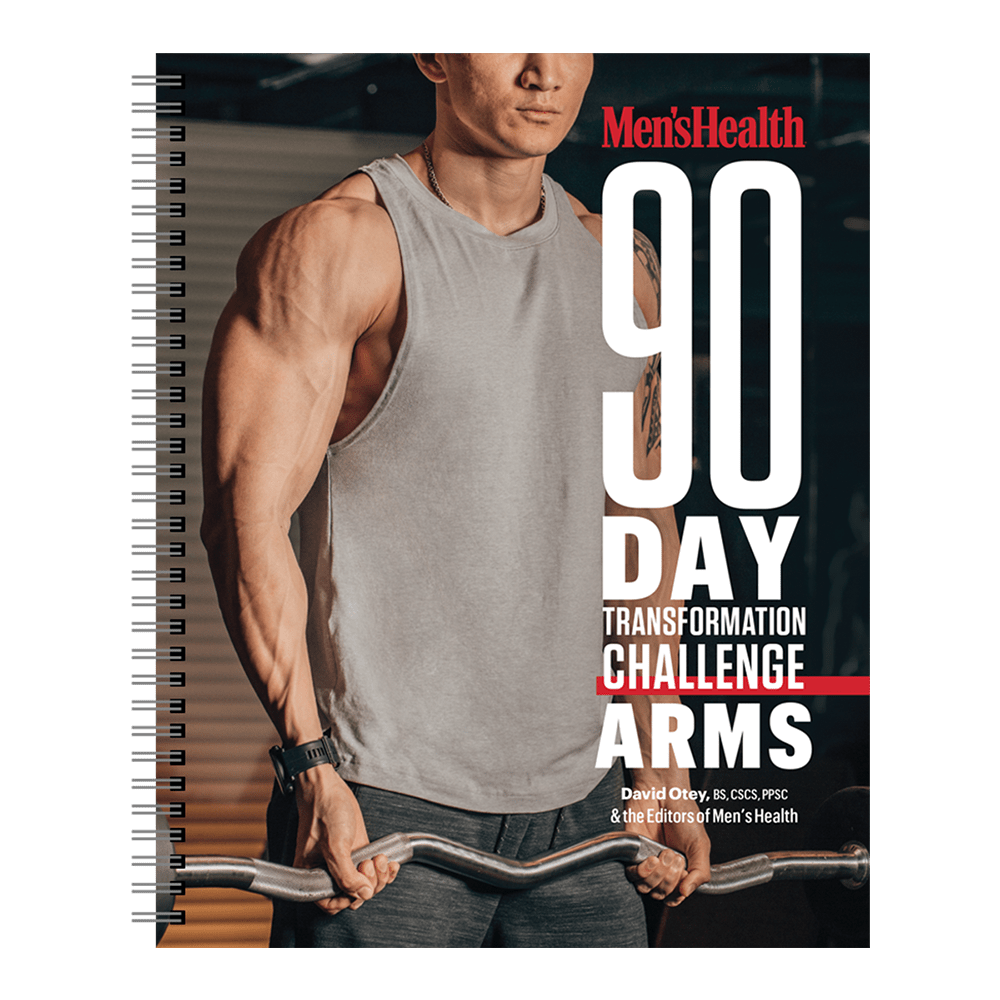

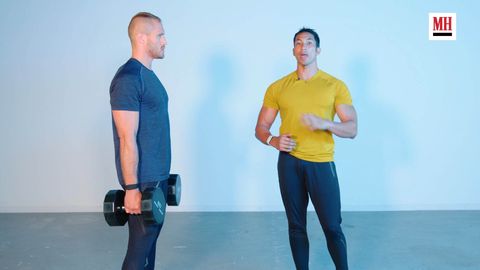
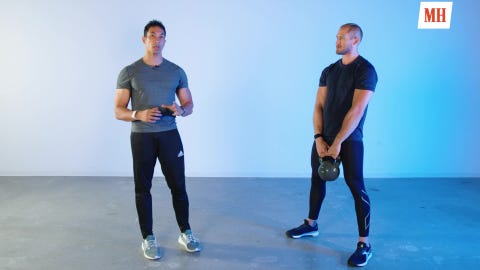
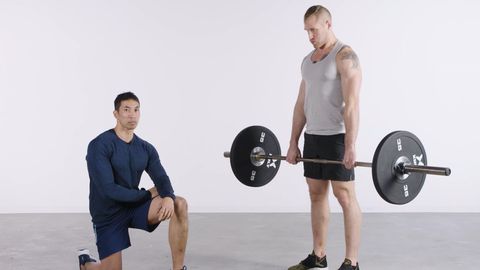
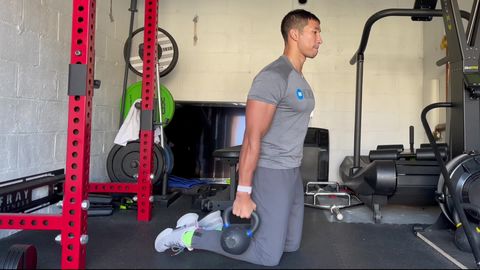
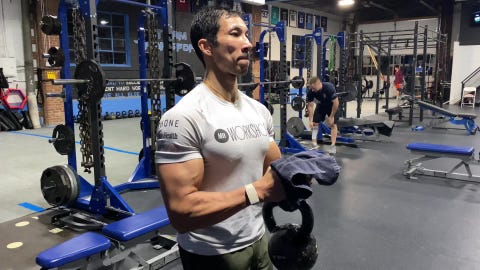

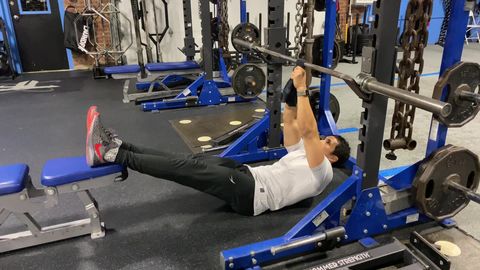
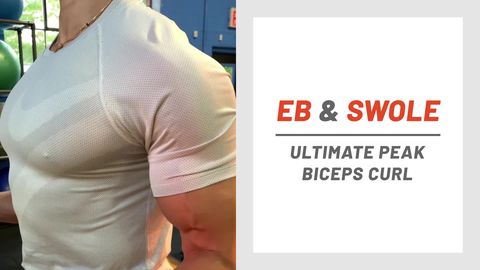
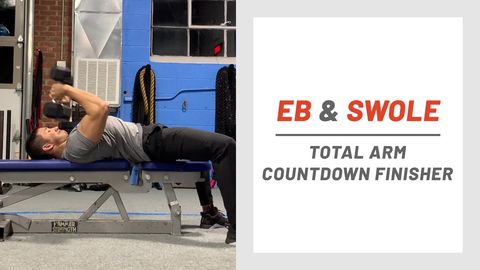
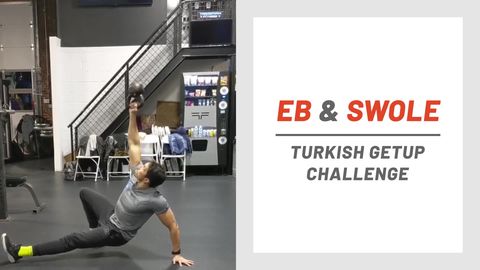
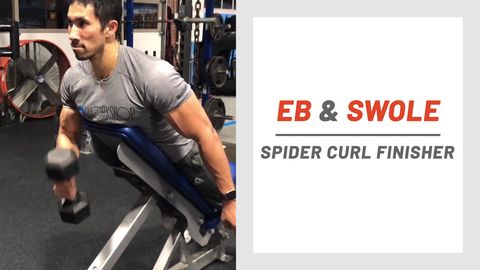
Comments are closed.